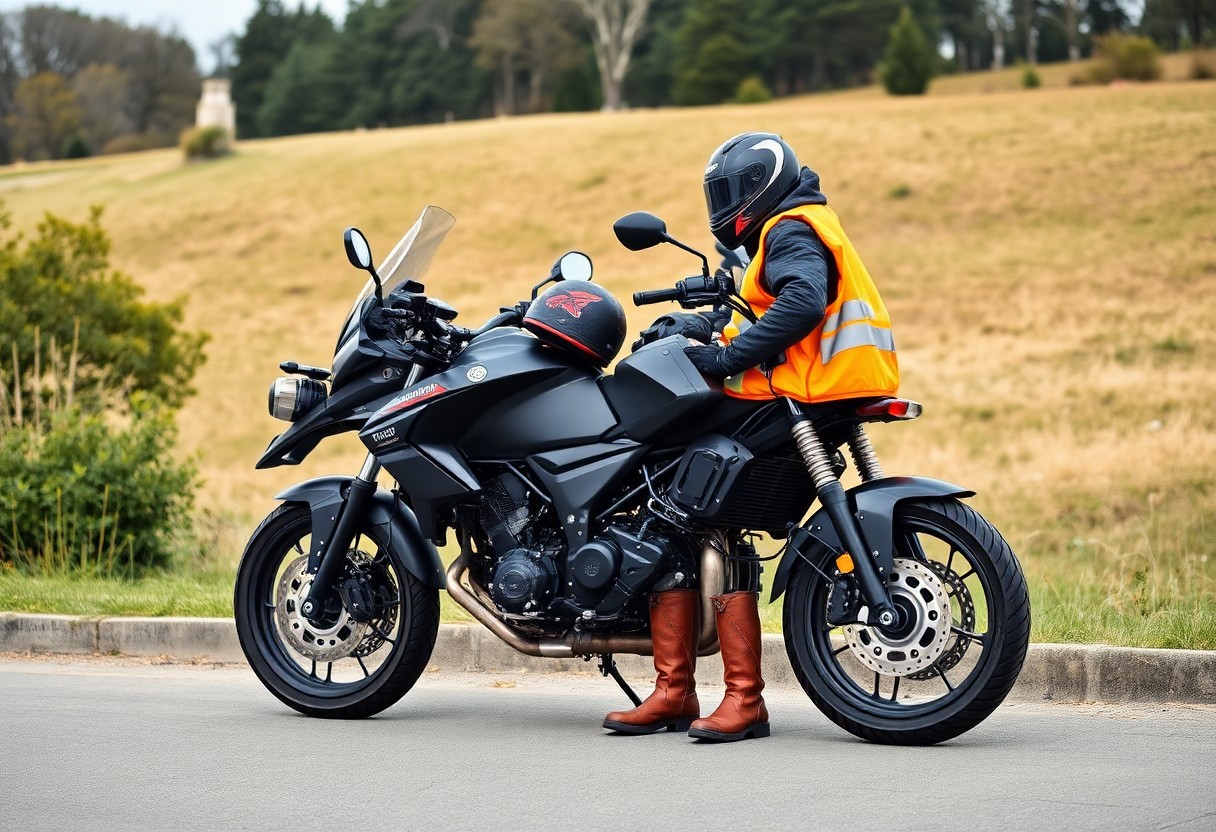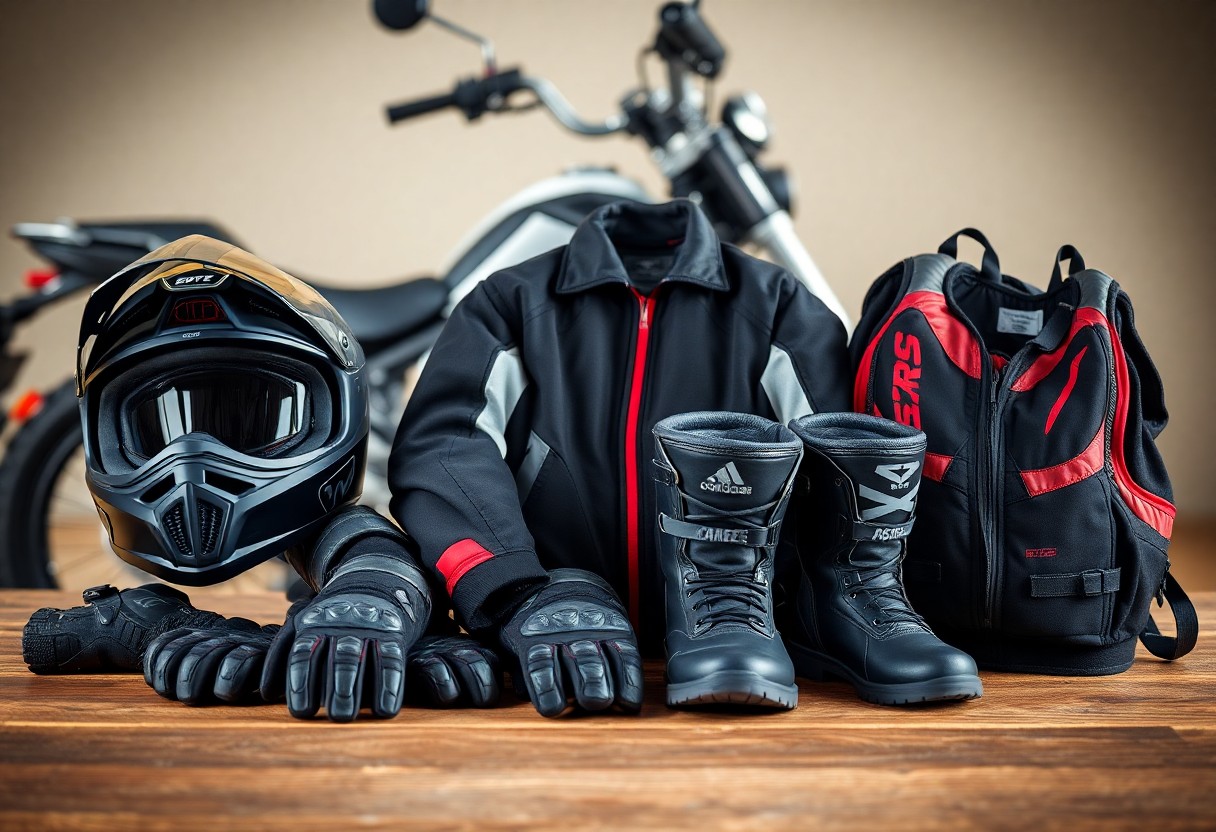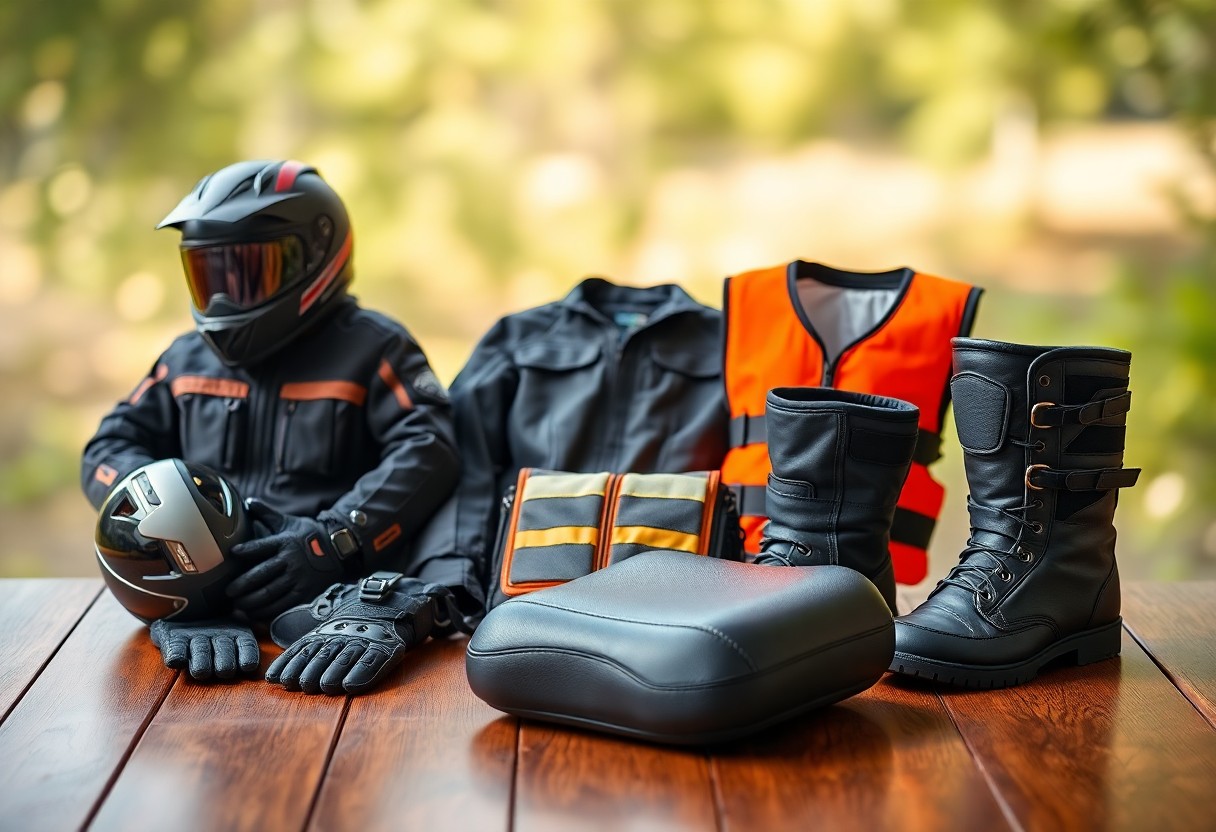Just as the open road calls to you, ensuring your safety while riding is paramount. In this comprehensive guide, you’ll discover the important motorcycle safety gear needed to protect yourself in any situation. From helmets to protective clothing, we’ll break down what truly matters for your safety and comfort. Equip yourself with the knowledge to make informed choices, allowing you to enjoy every ride while minimizing risks. Let’s examine the vital pieces of safety gear that every motorcyclist should consider for a safer journey on the road.
Understanding Motorcycle Safety Gear
The motorcycle safety gear you choose is important for protecting you on the road. It encompasses a range of products designed to mitigate injury from accidents and enhance your overall riding experience. By selecting the right gear, you not only ensure your safety but also enjoy greater comfort and style during your rides.
Types of Safety Gear
The types of safety gear available can vary significantly, catering to different needs and preferences. Here are some of the important items you should consider:
- Helmets
- Jackets
- Gloves
- Pants
- Boots
This variety ensures you can find gear that fits your style while providing adequate protection.
| Helmet | Essential for head protection and required by law in many areas. |
| Jacket | Offers protection against abrasions and impacts while providing extra visibility. |
| Gloves | Protect hands from injuries and improve grip on the handlebars. |
| Pants | Designed to safeguard your legs against abrasions and enhance comfort. |
| Boots | Provide support for ankles and protect your feet from injuries. |
Factors to Consider When Choosing Gear
When choosing motorcycle safety gear, it’s important to evaluate several factors to ensure your comfort and safety. Consider elements like fit, protection level, material quality, and visibility.
- Fit and comfort
- Protection ratings
- Weather resistance
- Visibility
- Budget
Assume that finding the right balance among these factors will significantly enhance your riding experience.
Understanding the different aspects of your chosen gear can further refine your decision-making process. Evaluating protection levels, comfort features, and durability will guide you toward the right choices based on your riding style and environment.
- Specific riding conditions
- Type of motorcycle
- Frequency of rides
- Personal style preferences
- Manufacturer reputation
Assume that investing time in this assessment will greatly enhance your safety and enjoyment while riding.
Essential Safety Gear
There’s no denying that the right safety gear can significantly reduce your risk on the road. Ensuring you have vital gear protects not just your body but also enhances your confidence while riding. Investing in quality equipment will contribute to both your safety and overall riding experience.
Helmets
Some may underestimate the importance of wearing a helmet, but it’s a fundamental element of motorcycle safety. A well-fitted helmet can reduce the severity of head injuries in the event of an accident, and many come with advanced features like ventilation and noise reduction for added comfort.
Jackets and Armor
Jackets designed for motorcycle riding offer both protection and style, incorporating armor in key areas to absorb impact during a fall. Look for jackets made from durable materials, with reinforced stitching, and an ergonomic fit for maximum comfort while you ride.
Plus, many jackets include additional features like waterproofing and reflective materials, which enhance visibility and keep you dry in various weather conditions. The right armor can include padding in the shoulders, elbows, and back, ensuring that you stay protected without sacrificing mobility.
Gloves and Footwear
To maintain a solid grip and protect your hands, investing in quality gloves is vital. They not only enhance your comfort while riding but also safeguard your palms and fingers in case of an accident.
Understanding the importance of footwear is equally significant, as sturdy, protective boots can help prevent injuries to your feet and ankles. Opt for boots with ankle support and slip-resistant soles, ensuring you have both safety and functionality while riding your motorcycle.
Tips for Selecting the Right Gear
Your safety gear is an investment in your riding experience. When choosing the right equipment, consider the following:
- Check safety ratings and certifications.
- Assess the climate and weather conditions you typically ride in.
- Look for features like visibility, ventilation, and flexibility.
- Read reviews from fellow riders for insights.
Any decision you make should prioritize your safety and comfort on the road.
Fit and Comfort
If your gear doesn’t fit properly, it can compromise your safety and comfort while riding. Ensure that all pieces are snug but not overly tight, allowing for freedom of movement. Consider trying on gear while sitting on your motorcycle to mimic real riding conditions, ensuring that the gear accommodates your riding posture.
Material and Durability
Clearly, the materials used in your motorcycle gear play a vital role in its performance and longevity. High-quality fabrics and reinforcements provide better protection against abrasion and impact, making them worth the investment.
It’s important to look for materials such as leather, Kevlar, or advanced synthetic fabrics that offer superior resistance and durability. These materials not only protect against abrasions in the event of a fall but also resist wear over time, adding value to your investment. Additionally, check for water-resistant and breathable options to enhance comfort in varying weather conditions.
Step-by-Step Guide to Gear Maintenance
After investing in high-quality motorcycle safety gear, it’s crucial to maintain it properly to ensure optimal performance and longevity. Follow this simple guide for effective gear maintenance:
| Maintenance Task | Frequency |
|---|---|
| Cleaning | After every ride or weekly |
| Inspection | Monthly |
| Replacement | As needed or based on usage |
Cleaning and Care
Any time you ride, dirt, grime, and moisture can accumulate on your safety gear. Regular cleaning not only enhances aesthetics but also maintains the effectiveness of protective materials. Use specialized cleaners appropriate for your gear’s materials and follow the manufacturer’s care instructions to avoid damaging them.
Inspection and Replacement
One of the best practices you can adopt is to regularly inspect your gear. This allows you to identify any wear and tear that may compromise its effectiveness. Schedule monthly check-ups to ensure everything is in good shape and replace items showing signs of significant damage.
For instance, inspect seams, zippers, buckles, and padding for any signs of deterioration. If your helmet has scratches or your jacket shows frayed stitching, consider replacing them to ensure your safety on the road. A proactive approach to inspection can extend the life of your gear while keeping you protected when you ride.
Pros and Cons of Different Gear Types
Many riders often grapple with the choice of gear types when prioritizing safety and comfort. Here’s a quick breakdown of the pros and cons to help you make informed decisions on your motorcycle gear:
| Gear Type | Pros | Cons |
|---|---|---|
| Full-Face Helmets | Maximum protection, good aerodynamics | Less ventilation, can feel claustrophobic |
| Open-Face Helmets | Better visibility, more airflow | Less facial protection |
| Textile Jackets | Lightweight, waterproof options available | Durability can be less than leather |
| Leather Jackets | Excellent abrasion resistance | Can be heavy and less weatherproof |
| Armored Gear | Protection in impact zones | Can be bulkier and less comfortable |
Full-Face vs. Open-Face Helmets
For motorcycle enthusiasts, choosing between full-face and open-face helmets typically hinges on protection versus comfort. Full-face helmets offer maximum coverage and are ideal for safety-conscious riders, while open-face helmets provide greater visibility and ventilation, making them popular for casual rides.
Textiles vs. Leather Jackets
Even seasoned riders might struggle to choose between textiles and leather jackets. Textile jackets are generally lighter and often designed to be water-resistant, while leather jackets are celebrated for their durability and superior abrasion resistance.
It’s crucial to factor in your riding style and climate when deciding between textiles and leather. Textile jackets often feature ventilation panels and are more adaptable to changing weather conditions, making them a versatile option for all-season riders. In contrast, leather jackets provide a classic aesthetic and considerable protection from abrasions but may lack breathability in hot weather. Each material has its benefits, and you should choose what aligns best with your personal riding needs and preferences.
Common Mistakes to Avoid with Safety Gear
Now that you understand the importance of safety gear, it’s important to be aware of common mistakes that could compromise your safety. Many riders make poor choices that detract from the protective capabilities of their gear. By avoiding these pitfalls, you can enhance your safety on the road and enjoy your ride with confidence.
Ignoring Safety Ratings
Avoid choosing safety gear without considering its safety ratings. Various organizations test and certify protective equipment, and these ratings ensure that the gear meets certain safety standards. Selecting gear that lacks proper certifications could leave you inadequately protected in the event of an accident.
Overlooking Visibility
Common mistakes include neglecting visibility when selecting your riding gear. Bright colors, reflective materials, and additional lighting can significantly increase your visibility to other road users, especially in low-light conditions or bad weather.
This is vital since the majority of motorcycle accidents involve other vehicles that may not see you until it’s too late. Opt for gear in bright colors, such as fluorescent yellow or orange, and incorporate reflective elements in your attire. Additionally, consider using lights on your motorcycle or wearing a reflective vest to further enhance your visibility. By prioritizing this aspect, you reduce the risk of accidents and help ensure a safer riding experience.
Summing up
As a reminder, investing in the right motorcycle safety gear is crucial for protecting yourself while riding. You should prioritize items such as a quality helmet, durable riding jacket, reinforced gloves, and sturdy boots. By ensuring that your gear meets safety standards and fits you well, you can significantly enhance your riding experience and overall safety on the road. Always make informed choices about the gear you wear, as it can greatly impact your ability to enjoy your motorcycle journeys safely.


